Most Obscure Sports: World Lumberjack Championships As a child, you may have discovered that chores go quicker when you make games out...
Most Obscure Sports: World Lumberjack Championships
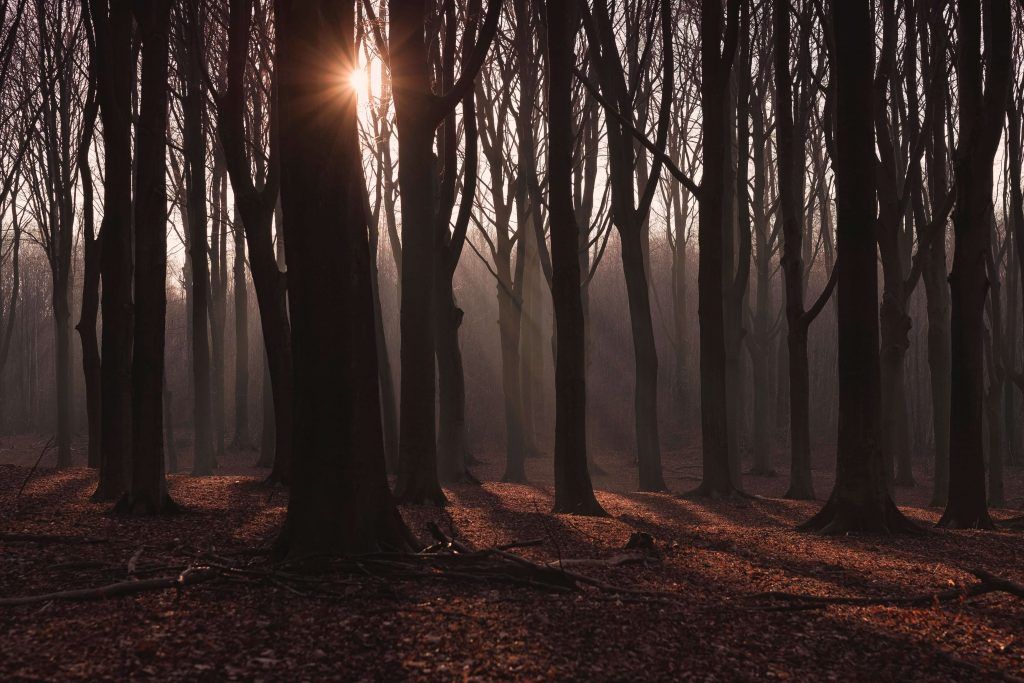
As a child, you may have discovered that chores go quicker when you make games out of them. For some that live in heavily forested parts of the world, taking that advice to heart has led to careers as professional athletes.
Sports like rodeo, fishing, sailing and many others were born out of trying to do some sort of otherwise useful task better than the next guy. In another example, legend has it that in the 1870s two Tasmanian loggers argued over who could chop down a tree faster.
In what their managers probably viewed as a productivity godsend, these kinds of informal competitions became the pastime of choice for lumberjacks. Over the next century, more organized contests started to emerge in Europe, the United States, Australia, and other parts of the logging world.
Modern Lumberjack Sports
Today, these lumberjack competitions (also called logging sports, timbersports, or woodsman teams) bring in huge audiences (both live and televised) to see their amateur, collegiate, and professional competitors.
Modern competitions have evolved from simple tree chopping contests (though that’s definitely still a thing).
Nearly all include some combination of the following events:
● Logrolling: two athletes stand on a long floating log and try and make their opponent fall off by rotating, stopping, and bouncing the log.
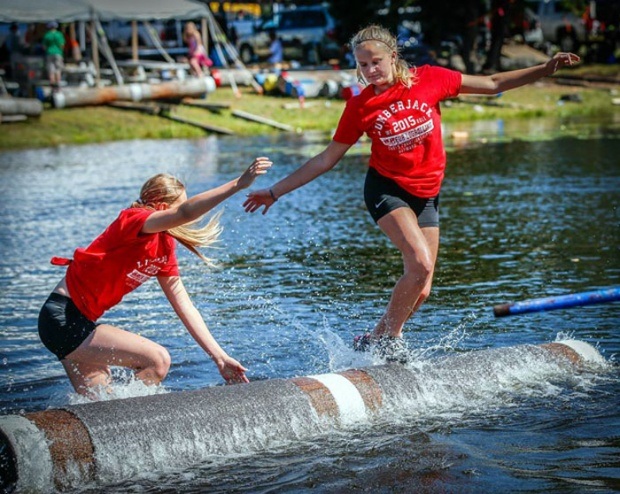
Image Credit: StillwaterGazette.com
● Boomrun: Competitors race back and forth across a ‘boom’ or chain of spinning, floating logs.
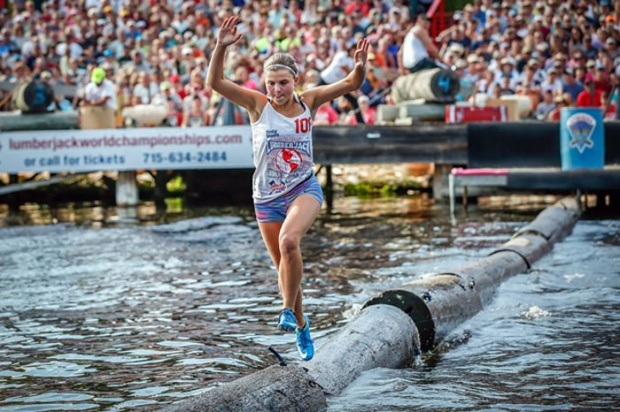
Image Credit: StillwaterGazette.com
● Block chop: Use a small axe to chop through a log that’s 11-12 inches thick.
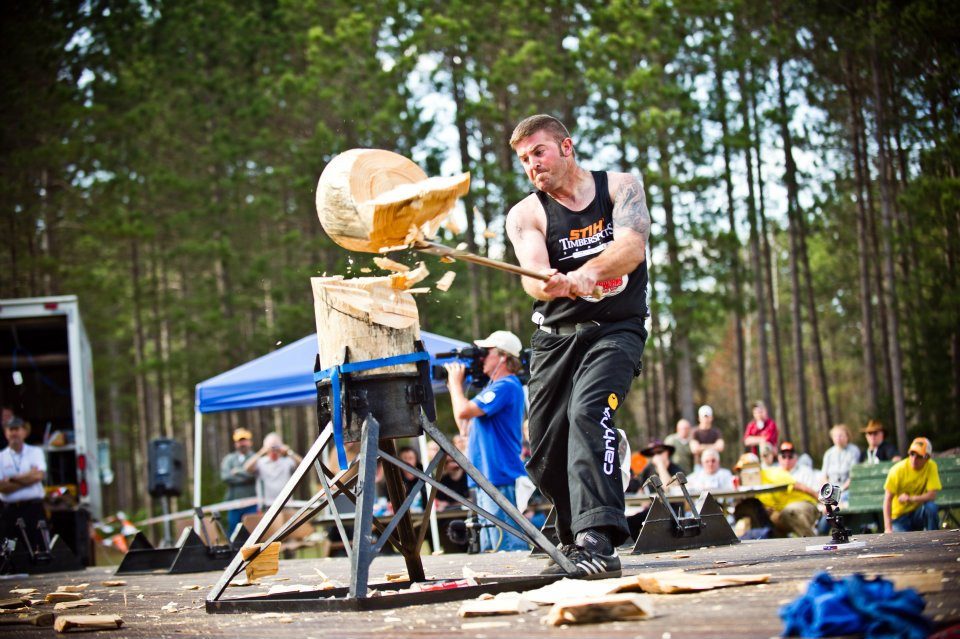
Image Credit: StihlUSA.com
● Speed climb: Using spiked shoes and a climbing rope, athletes race up and down a cedar pole as tall as 90 feet.
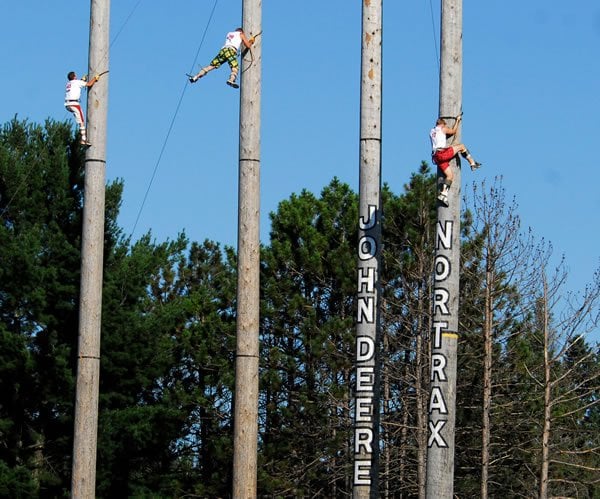
Image Credit: Lumberjackworldchampionships.com
● Hot saw: A timed competition to see how fast three cuts (up, down, and up) can be made on a 20-inch thick log.
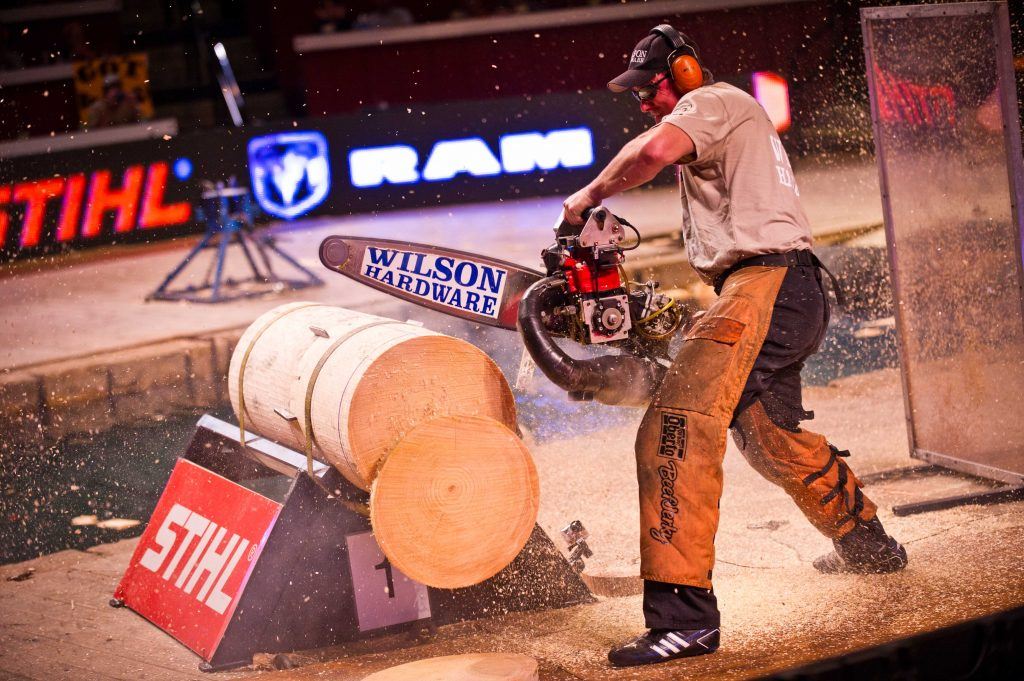
Image Credit: PRWeb.com
Chopping to the Top
The best lumberjacks not only have to wear plaid fashionably, they have to be versatile athletes too. While you might think any strong athlete could just show up and do well in most events, most of them be outright embarrassed by professional and even collegiate lumberjacks.
The sport’s pros come in all shapes and sizes, but most look exactly like what you’ve always known lumberjacks look like in cartoons and on paper towel packaging: tall, thick, and strong. Many have also been training in the sport (be it on the job or more deliberately) since the events were still just chores.
In some hotbeds for the sport, kids as young as 10 or 11 start taking logrolling classes. Others participate in timbersports training camps, such as the four-week long Timber Training program in Squamish, British Columbia.
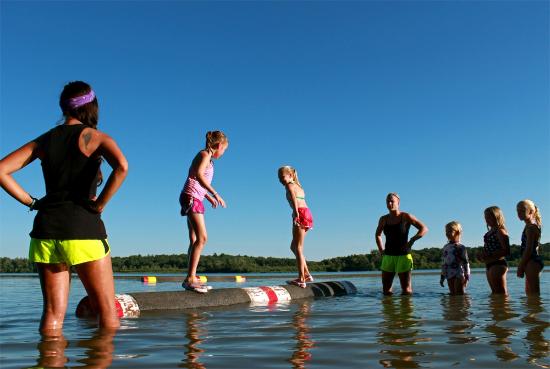
Image Credit: TripAdvisor.com
Like with any other sport, there are countless fitness programs you can follow if you desire to one day climb, chop, saw, cut, and roll with the best.
While these programs may get you strong and conditioned, only those that find the time and resources to actually work with real wood (often in a chipyard or on the job) tend to achieve timbersports glory.
Timbersports’ Big (Wooden) Stage
In few places will you find more athletes pursuing that dream than in the northern United States, particularly in Wisconsin. There you’ll find Hayward, a small town of about 2,000 that has hosted the Lumberjack World Championships since 1960.
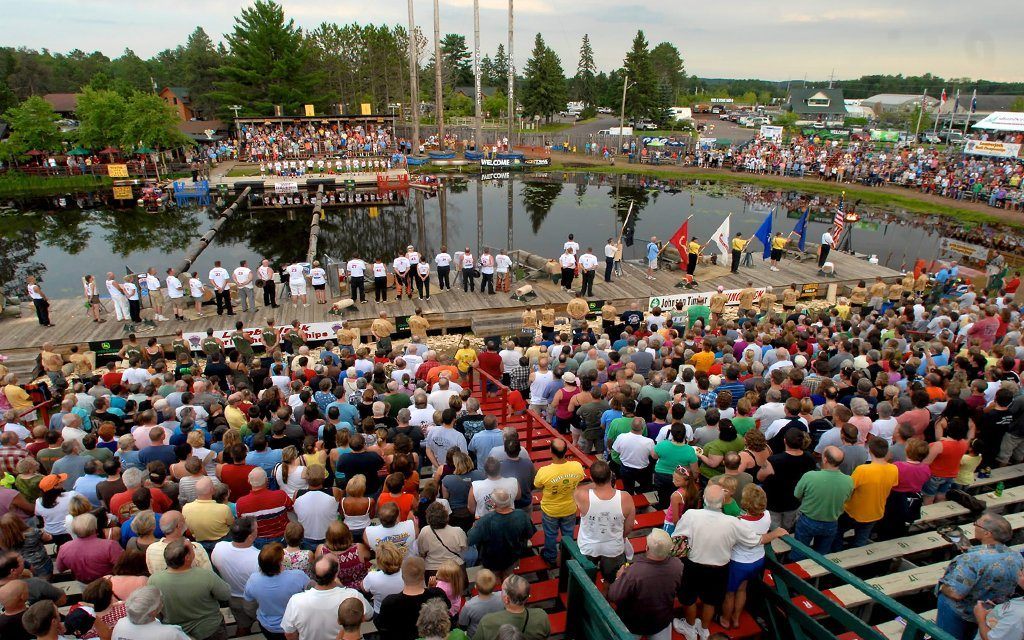
Image Credit: InsideHook.com
Held annually at the end of July, the event sees 100 men and women from around the world compete for a $50,000+ purse.
The showcase includes 21 different sawing, chopping, climbing, and logrolling events as well as three different team events.
The lumberjack that scores the most overall points in the competition is awarded the illustrious Tony Wise All-Around Champion Award, while the best lumberjill (female competitor) wins the All-Around Lady Jill Award.
Over 12,000 spectators turn up for the event each summer, and until recently the Lumberjack Championships were seen by many more on ESPN as part of their Great Outdoor Games programming.
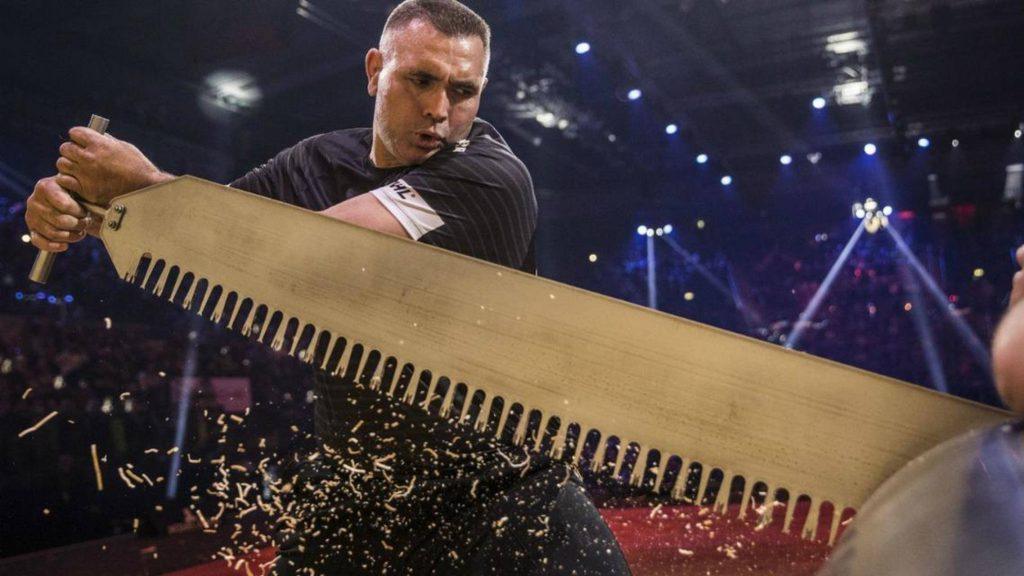
Image Credit: Newshub.co.nz
Other major competitions in lumbersports include the European Championship in Forestry Skills, the World Logging Championships, and the Stihl Timbersports Series which showcases six different climbing, cutting, chopping, and sawing-related disciplines.
Since its humble Wisconsin beginnings in 1985, Stihl’s series has expanded to have separate competitions and records for collegiate, Canadian, European, American and World competitors.The Series has been an ESPN programming staple since the early 90s, is the network’s longest running program besides SportsCenter, and is watched by over 20 million annually in 62 countries.
A Clean Cut Sport
While it might seem like PED use would give athletes a clear advantage, lumberjacking sports have largely remained as wholesome as their roots.
Being born out of such a time-honored job has seemingly helped them avoid ever having a major scandal to their name (save for the occasional accident that naturally comes along with wielding saws and axes).
Instead, these athletes have found success simply by focusing on the backbreaking work few others want to do.
20 proofs of casual sexism in the world of sports
Sexism in sports? You’d better believe it’s a serious problem. From unequal salaries and skimpy outfits to discrimination and harassment, female athletes and other women involved in sports often find they have plenty of extra hurdles to clear because of their gender. Here’s a look at the many different ways in which sexism affects the sports world.
Sports world mourns loss of Linkin Park frontman Chester Bennington
General Sports
FILE - In this May 26, 2017 file photo, Chester Bennington, of Linkin Park, performs “Hallelujah” at a funeral for Chris Cornell at the Hollywood Forever Cemetery in Los Angeles. The Los Angeles County coroner says Bennington, who sold millions of albums with a unique mix of rock, hip-hop and rap, has died in his home near Los Angeles. He was 41. Coroner spokesman Brian Elias says they are investigating Bennington’s death as an apparent suicide but no additional details are available. (Photo by Chris Pizzello/Invision/AP, File)
The world was dealt quite the shock when the death of Linkin Park frontman Chester Bennington was reported.
Before his untimely passing, Bennington starred as the talismanic leader of the alternative rockband that touched and influenced a lot of people in the 2000s.
With their unique mix of two polar opposite genres, Linkin Park was able to bring together people from different backgrounds who had varying taste in music.
So wide was Bennington and his group's reach, that even today's sports stars offered their words and took to Twitter to voice out their grief, and admiration for the late vocalist.
Kobe Paras even noticed the Linkin Park playlist that was booming through the gym's speakers as they were warming up before a game against Lithuania in the 39th William Jones Cup.
The Los Angeles Dodgers' organist even paid his respects to Bennington by playing his rendition of Link Park's hit single "Numb" before the team took on the Atlanta Braves in the MLB.
----
Bennington's death was reported as an apparent suicide, per TMZ, the first news outlet to break the story. He was 41.
Meanwhile, a group in the Philippines is dedicated to addressing those who have suicidal tendencies.
The crisis hotlines of the Natasha Goulbourn Foundation aim to help embattled individuals know that someone is ready to listen to them.
These are their hotline numbers: Information and Crisis Intervention Center (02) 804-HOPE (4673) 0917-558-HOPE (4673) or (632) 211-4550 0917-852-HOPE (4673) or (632) 964-6876 0917-842-HOPE (4673) or (632) 964-4084.




No comments